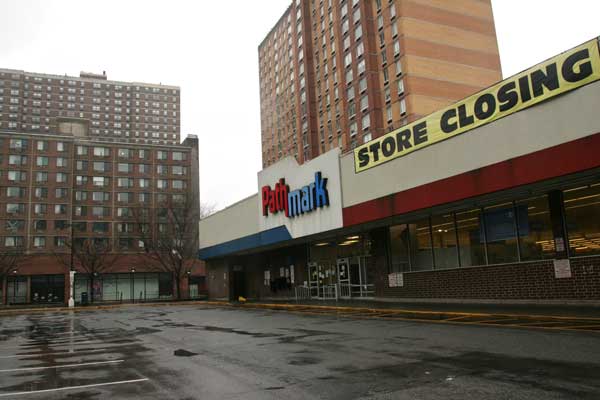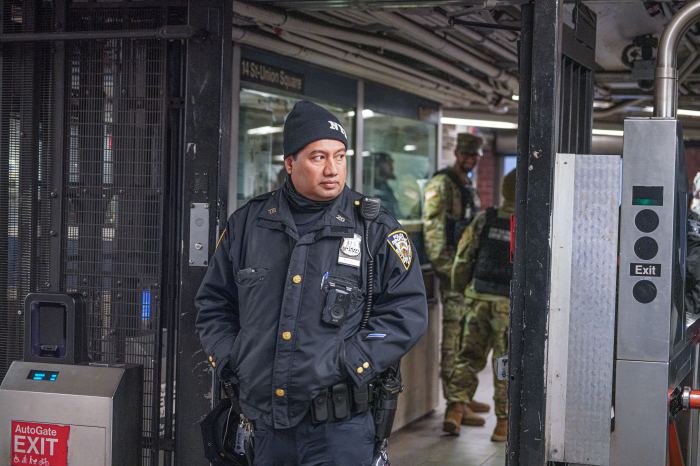
Pathmark’s parking lot is now empty.
BY SAM SPOKONY | Lower East Side community leaders are optimistic about the progress of a survey aimed at helping the Two Bridges neighborhood strengthen its local food economy, following the Dec. 22 closing of a Pathmark supermarket that had for nearly three decades been a lifeline for that neighborhood’s elderly and low-income residents.
In an interview last Friday, Victor Papa, president of the Two Bridges Neighborhood Council, expressed his confidence about the project — which also aims to produce a local grocery-shopping guide — and said that results of the community food survey will play an important role in his upcoming meeting with A&P C.E.O. Sam Martin, which will take place in Two Bridges on Jan. 7.
A&P, which owns Pathmark, sold the supermarket’s 227 Cherry St. lot earlier this year to an unnamed buyer that is widely believed to be Extell Development Company, which is led by Gary Barnett, one of the city’s top luxury residential developers.
Barnett continues to decline comment.
Since the sale was announced in September, Papa has represented thousands of residents who live near the Brooklyn or Manhattan bridges in their call for a Pathmark supermarket and pharmacy to remain on Cherry St., regardless of how the lot is developed. Many of those residents have said that Pathmark was their only local, affordable option for purchasing fresh groceries.
But now that the supermarket is officially shut down — the pharmacy closed in late-October — he has had to adjust the requests toward more practical and realistic ends.
Papa explained that, at this point, he has two primary ideas to introduce in the Jan. 7 meeting, both of which focus on maintaining at least some Pathmark presence in an area that includes several large public housing developments and senior homes.
His first recommendation will be for Martin and A&P to place a scaled-down, temporary supermarket in the small, adjacent Cherry St. lot that had been occupied by the pharmacy. Papa had already mentioned that idea several weeks ago, but on Friday he seemed more set on the possibility.
Papa’s other idea would call for a central Pathmark drop-off location in Two Bridges, to which other supermarkets within the chain — those in Harlem or Gowanus — could deliver food to be purchased by residents. This spawned from an earlier idea that involved bussing Two Bridges residents to those other supermarkets.
‘The delivery idea might be a little far-fetched,’ Papa said, ‘but we just want to make sure (Pathmark) stays connected, no matter how that connection is manifested.’
He also said he believes the results of the Two Bridges Community Food Assessment, a residential survey that ran from late-November to Dec. 14, will supply Martin with some ‘interest’ in retaining a Lower East Side presence.
James Johnson-Piett, principal and C.E.O. of Urbane Development, the food and local economy consultant group hired to assist on the survey and other post-Pathmark projects, said that while actual results are still being compiled, he’s pleased with what’s taken place so far.
The survey received responses from 326 residents, Johnson-Piett noted, exceeding the 250 he had originally sought. He added that the responses were a ‘good mix,’ meaning that they came via both paper and electronic surveys, as well as from a variety of demographics.
The assessment will likely show the extent to which Two Bridges residents — many of whom are elderly or on low-incomes — relied on Pathmark as their primary food source. But it was also designed to highlight smaller local grocery stores, or larger stores located slightly farther away, that may become more frequent options in the absence of Pathmark.
Now that the community survey is complete, staff members from Urbane, in association with Two Bridges Neighborhood Council, have already begun the second phase of their efforts, which involves surveying those other local stores.
Johnson-Piett said that at least 15 stores had already been surveyed over the course of a few days. He plans to include data from around 150 additional stores during the first half of January, while also conducting more in-depth interviews with some store owners by the end of the month.
‘So far, I’ve really been surprised and impressed by the business owners’ willingness to get involved in what we’re doing,’ Johnson-Piett said. About 75 percent of the Two Bridges stores have cooperated in the survey, he explained, compared to an average of around 10 percent in similar past projects he’s completed in other cities.


































